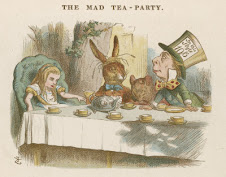A new Pew Research Center survey finds a perfect storm of conditions associated with distrust of government – a dismal economy, an unhappy public, bitter partisan-based backlash, and epic discontent with Congress and elected officials . . .The report devotes an entire section to the "Tea Party and Views of Government Overreach," which also relays the results to a question inquiring as to what group best reflects the views of the survey's respondents, offering a choice between the Democratic Party, the Republican Party, the Tea Party, the Green Party, "Some Other Group" or "None of These." The findings are worth pondering:
The public’s hostility toward government seems likely to be an important election issue favoring the Republicans this fall. However, the Democrats can take some solace in the fact that neither party can be confident that they have the advantage among such a disillusioned electorate. Favorable ratings for both major parties, as well as for Congress, have reached record lows while opposition to congressional incumbents, already approaching an all-time high, continues to climb.
 According to this poll, a majority of Americans refuse to identify with either the Democrats or Republicans, with only 48% of respondents stating that the Democratic or Republican Party best reflects their views! One is justified in wondering how many of these folks would go on to admit that the Democratic or Republican Party does not in fact reflect their views if they were pressed on the issue. Given that Democrats and Republicans control 99% of elected offices, but can only garner the explicit support of 48% of the population, it is no wonder that one finds an "epic discontent" among the public.
According to this poll, a majority of Americans refuse to identify with either the Democrats or Republicans, with only 48% of respondents stating that the Democratic or Republican Party best reflects their views! One is justified in wondering how many of these folks would go on to admit that the Democratic or Republican Party does not in fact reflect their views if they were pressed on the issue. Given that Democrats and Republicans control 99% of elected offices, but can only garner the explicit support of 48% of the population, it is no wonder that one finds an "epic discontent" among the public.It is noteworthy that the Green Party was explicitly included in this selection of choices. Of late, most polling organizations that have ventured to gauge opinion relative to groups other than the Democrats and Republicans have not stepped beyond questions regarding the tea party, offering a choice of the Democratic Party, the Republican Party, the Tea Party or "some other group." Perhaps the Green Party was included simply as a gesture signaling political balance, as a third party alternative to the Democrats on the assumption that the Tea Party represents an independent alternative to the GOP. One might also question the inclusion of both "Some Other Group" and "None of These" for its redundancy.
Nonetheless, if we read those who identify with the Republican Party and the Tea Party as a single bloc, the overall breakdown into three ideological groups is quite familiar, with 31% in support of Democrats, 31% in support of a perceived conservative alternative to the Democrats (i.e. GOP or Tea Party) and 28% who identify with none of the named options, otherwise known as independents.
In related findings, respondents were more likely to agree with the statement that "the political system can work fine, it is the members that are the problem" (52%) rather than the assertion that "most members have good intentions, it's the political system that is broken" (38%). There is widespread agreement that elected officials are: not careful with the government's money (83%), influenced by special interest money (82%), concerned only about their careers (81%), unwilling to compromise (78%), and out of touch with regular people (76%).
Conclusion: Democrats and Republicans are rigidly ideological careerist elites, and profligate spenders of taxpayer dollars, who have been bought and paid for by the interest groups who benefit most from their policies. But the question remains: how much longer will Americans continue to support the Democratic-Republican two-party state and ruling criminal-political class?







No comments:
Post a Comment